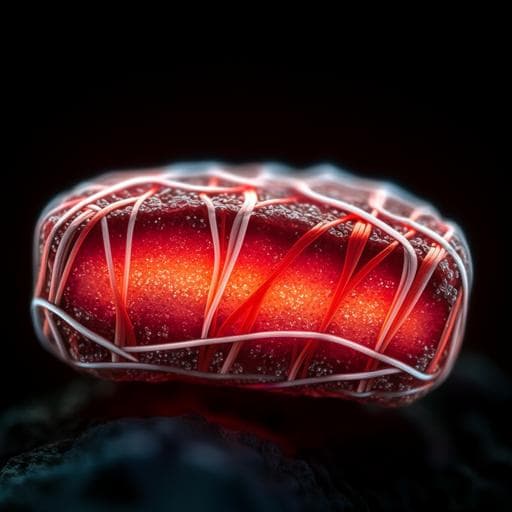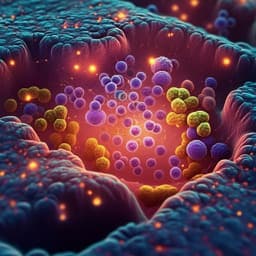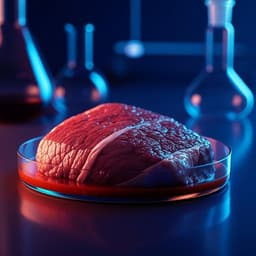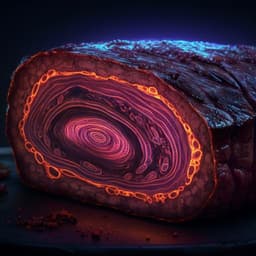
Food Science and Technology
Engineered whole cut meat-like tissue by the assembly of cell fibers using tendon-gel integrated bioprinting
D. Kang, F. Louis, et al.
This groundbreaking study, conducted by a team of experts including Dong-Hee Kang and Fiona Louis, pioneers the in vitro construction of steak-like tissue using engineered bovine cell fibers, merging muscle, fat, and vessel components with a novel tendon-gel bioprinting technique.
~3 min • Beginner • English
Introduction
The study addresses the challenge of producing structured, steak-like cultured meat that recapitulates the aligned architecture and composition of real beef, which consists of muscle fascicles, adipose tissue, and vasculature connected to tendons. While plant-based analogs exist and cell-based meats have been demonstrated (e.g., minced products), generating whole-cut, aligned muscle with integrated fat and vessel components remains difficult. The authors posit that 3D bioprinting, particularly supporting bath-assisted printing (SBP), can overcome limitations in bioink viscosity and structural fidelity during long prints. They aim to develop a method to fabricate tendon-anchored, aligned bovine muscle fibers along with adipose and vascular fibers, and to assemble them into a steak-like construct with controlled component ratios and spatial arrangement inspired by Wagyu beef.
Literature Review
The paper situates its work within prior cultured meat and tissue engineering efforts: earlier demonstrations include cell-sheet engineering, cell fiber engineering, 3D scaffolds, and 3D bioprinting. SBP has shown promise for complex soft-tissue fabrication due to thixotropic support media enabling high-fidelity structures. The authors highlight the structural hierarchy of meat (muscle fibers bundled into fascicles, surrounded by fat and capillaries, anchored to tendon) and variability in fat content across cuts and breeds (e.g., Wagyu). They identify gaps: limited reports of whole-cut structured cultured meat with aligned muscle and integrated adipose/vascular components; limited bovine-specific protocols for robust adipogenesis (especially late markers like FABP4) and endothelial differentiation from bovine ADSCs, unlike human ADSCs.
Methodology
The authors implemented a three-step strategy: (1) isolate and expand edible bovine satellite cells (bSCs) and bovine adipose-derived stem cells (bADSCs); (2) develop tendon-gel integrated bioprinting (TIP) to fabricate cell fibers and induce differentiation into skeletal muscle, adipose, and vascular fibers; (3) assemble differentiated fibers into a steak-like construct.
Cell isolation and characterization: bSCs were extracted from masseter muscle of 27-month-old Japanese black cattle. After collagenase digestion and sorting (CD31−, CD45−, CD56+, CD29+), Pax7+ bSCs were ~80%. Proliferation and myogenic differentiation were assessed across passages in 2D; differentiation medium was DMEM + 2% horse serum (HS). Differentiation was quantified by MHC immunostaining relative to DAPI. bADSCs were isolated from subcutaneous adipose tissue via collagenase digestion to obtain stromal vascular fraction; expanded to P1-P5.
Adipogenic differentiation optimization (3D): bADSCs were embedded with collagen microfibers (CMF, 1.2 wt%) in fibrin gel. Conventional adipogenic factors (insulin, PPARγ agonists) yielded limited lipogenesis, so seven free fatty acids (pristanic, phytanic, erucic, elaidic, oleic, palmitoleic, myristoleic) were added; combinations were compared, with maximal lipid accumulation using all seven. To enhance adipogenesis and adipocyte hypertrophy, ALK5 inhibitor (ALK5i) was tested (1–10 μM), optimal at 5 μM. Adipogenesis was evaluated by lipid staining (Nile Red), immunostaining for PPARγ2 (nuclear early marker) and FABP4 (late cytoplasmic marker), and RT-qPCR.
Endothelial differentiation from bADSCs: bADSCs (P1) were tested in various sera and media; horse serum (1–10%) markedly increased CD31 expression (up to ~15-fold vs 10% FBS), independent of DMEM or F12K. DMEM + 10% HS was selected. Tubulogenesis was confirmed on Matrigel after 7 days.
Supporting bath-assisted 3D printing (SBP): Bioinks contained bSCs in fibrinogen/Matrigel solution. Supporting baths were granular gellan gum (G-GG) or granular gelatin (G-Gel), both thixotropic and edible/removable. Printing used a 16G nozzle, 1 mm/s movement, 2 μL/s dispensing, at 4 °C. After gelation, baths were removed (G-GG with Tris buffer, G-Gel by warming). Cultures were either suspension or needle-anchored at both ends to resist contraction. Cell alignment and maturation (MHC, actin) were assessed.
Tendon-gel integrated bioprinting (TIP): To provide integrated anchorage, TIP introduced collagen nanofiber (CNF) tendon gels. A PDMS well formed a stratified bath: bottom CNFs, middle G-Gel (printing layer), top CNFs. After printing, an additional CNF layer covered the print; warming to 37 °C dissolved G-Gel and gelled CNFs, creating tendon-like anchors at both ends of the printed fiber. Muscle fibers used bSC bioink; fat fibers used bADSCs in CMF (1.2 wt%) with fibrinogen; vascular fibers used endothelial-differentiated bADSCs in CMF/fibrinogen. Multiple printing allowed up to 25 fibers in a large well. Differentiation followed optimized media: bSCs to myotubes (HS), bADSCs adipogenesis (7 FAs + 5 μM ALK5i), endothelial (DMEM + 10% HS). Viability, alignment, MHC expression (IF and RT-qPCR), sarcomere formation (long-term), and adipogenic/endothelial marker expression (IF, RT-qPCR, western) were measured.
Mechanical and compositional characterization: DNA content normalized to wet weight, compressive modulus (PFA-fixed fibers under spherical indentation), and water content were measured and compared with commercial beef-derived muscle and fat fibers of similar dimensions.
Assembly of engineered steak: Based on histology of Wagyu beef (sarcomeric α-actinin and laminin stains), a model specified fiber counts and diameters (muscle ~500 μm, fat ~760 μm, vascular ~600 μm). TIP-fabricated fibers were manually stacked according to the model (42 muscle, 28 fat, 2 vascular). Muscle and vascular fibers were food-color stained red; fat remained white. Assembly was stabilized with transglutaminase (10 U/mL) at 4 °C for 2 days, then imaged (top and cross-section) for structural analogy.
Analytical methods: Confocal imaging (live/dead; actin/MHC), ImageJ quantification for alignment angles and lipid content; RT-qPCR for MYH2, PPARG, FABP4, CD31/PECAM1 normalized to PPIA; western blot for MYH2 (MHC), PPARγ, FABP4; rheology for bath thixotropy; SEM for muscle fiber ultrastructure; statistics via ANOVA and t-tests as appropriate.
Key Findings
- bSC proliferation and differentiation: bSCs doubled approximately once per day until passage 8 (P8), then every ~2 days; differentiation capacity (MHC+) was maintained from P3–P7 but significantly decreased above P8.
- bADSC adipogenesis: Media containing all seven free fatty acids produced the highest lipogenesis; adding 5 μM ALK5i further increased lipid accumulation. PPARγ2 showed early nuclear expression (day 3), diminishing by day 14; FABP4 increased in cytoplasm with maturation. RT-qPCR showed significant, linear increases of PPARG (PPARγ2) and FABP4, with FABP4 rising to a higher extent by day 14.
- Endothelial differentiation: Horse serum markedly enhanced CD31 expression—approximately 4-fold (1% HS) and 15-fold (10% HS) over 10% FBS; DMEM + 10% HS chosen. Differentiated cells formed tubular structures on Matrigel.
- SBP and anchoring: In suspension, printed bSC fibers lost alignment and often rounded; needle anchoring preserved fiber shape but fibers shrank in diameter by ~60% (G-GG) and ~80% (G-Gel) by day 9. Needle anchoring improved anisotropic alignment, particularly with G-Gel; residual G-GG in fibers impeded remodeling and alignment.
- TIP efficacy: TIP produced tendon-anchored muscle fibers that maintained fibrous structure and promoted alignment. MHC mRNA was upregulated ~1000-fold by day 3 of differentiation versus naive bSCs. Sarcomere structures appeared in some TIP-derived fibers after 14 days, indicating maturation. Multiple printing enabled fabrication of 25 fibers in one well.
- Adipose fiber markers by TIP: Compared to naive bADSCs, PPARG mRNA increased >6-fold and FABP4 >40-fold by day 14; protein levels of PPARγ and FABP4 increased >2-fold.
- Physical properties vs commercial meat: DNA per weight in TIP muscle fibers was ~6× lower than in meat; in TIP fat fibers, DNA amount increased by day 14 beyond that of commercial fat fibers, indicating proliferation. Compressive modulus of TIP muscle (day 3 of differentiation) and fat (day 7 of differentiation) fibers were within the same order of magnitude (kPa) as meat; water contents differed from meat.
- Steak-like assembly: TIP yielded fibers with diameters ~500 μm (muscle), ~760 μm (fat), ~600 μm (vascular). Assembling 42 muscle, 28 fat, and 2 vascular fibers with transglutaminase produced a ~5×10×5 mm construct whose cross-sectional appearance resembled Wagyu beef histology.
Discussion
The findings demonstrate that tendon anchorage is critical for maintaining alignment and promoting maturation in printed bovine muscle fibers. TIP integrates collagen tendon gels with printed fibers, overcoming limitations of suspension culture and the impracticality of external needle anchoring for scale-up. Optimized adipogenesis using a bovine-tailored combination of seven fatty acids plus ALK5i yielded mature adipocyte markers, while bADSCs served as a practical source for endothelial-like cells under horse serum stimulation, avoiding the need to isolate primary bovine endothelial cells. Together, these enable fabrication of three key tissue fiber types—muscle, fat, and vascular—necessary for steak-like structure.
Mechanical and compositional comparisons reveal that while stiffnesses approach those of meat, discrepancies in cell density (DNA content) and water content remain, indicating further optimization of bioink cell/ECM concentrations and maturation protocols is needed to match native tissue. The manual assembly of 72 fibers into a small steak-like sample validates the feasibility of designed composition and spatial arrangement, supporting TIP as a manufacturing technology for structured cultured meat. The approach may also translate to broader muscle tissue engineering applications.
Conclusion
This work introduces tendon-gel integrated bioprinting (TIP) to fabricate tendon-anchored, aligned bovine muscle fibers alongside adipose and vascular fibers from edible primary bovine cells, and assembles them into a steak-like construct mimicking Wagyu beef. Key advances include bovine-specific adipogenic induction (seven fatty acids + ALK5i) achieving late adipocyte markers, and efficient endothelial differentiation of bADSCs with horse serum. TIP maintained fiber integrity and alignment, enabling maturation with sarcomere formation, and produced constructs with mechanical properties in the kPa range comparable to meat. Future work should focus on scale-up and automated multi-material printing, co-culture media enabling simultaneous maturation of all fiber types, improving cell density and water content to match native tissue, ensuring fully edible materials and processes, and incorporating sensory attributes (tenderness, flavor, nutrition) for consumer products.
Limitations
- bSCs showed reduced proliferation and differentiation capacity after P8, limiting scalability; strategies to maintain stemness are required.
- Occasional detachment of tendon gels during prolonged culture due to strong contraction; stronger CNF concentrations or additional cross-linking may be needed.
- TIP-derived muscle fibers had lower DNA content per weight (~6× less) and water content differed from meat; optimization of cell/ECM concentration and maturation is necessary.
- MHC protein expression in TIP fibers was relatively lower than needle-fixed culture at early time points.
- The assembled construct was small (∼5×10×5 mm) and inedible in its current form; full edibility of materials and media and process scaling were not achieved here.
- Assembly was manual; automated, precise multi-material deposition and integrated co-culture media were not demonstrated.
- Sensory properties (tenderness, flavor) and nutritional profiles were not optimized or evaluated.
Related Publications
Explore these studies to deepen your understanding of the subject.







